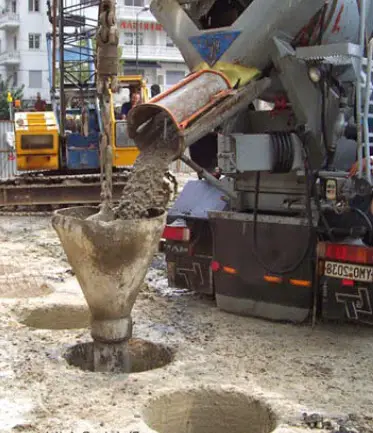Concrete is the most popular building material. Concrete is made by mixing cement with sand, aggregates and water in a certain ratio. The correct proportions of the components in the concrete mix will determine its strength and durability. We will be discussing how to calculate the required cement, sand and aggregate for concrete M15 grade.
The M15 concrete grade is a medium-strength concrete mixture with a compressive strength 15 MPa or 2175 PSI. M15 grade concrete has a mix ratio of 1:2:4, meaning that it contains one part cement and two parts sand. It also contains four parts aggregate.
Let’s now discuss how to calculate the required amount of each component for one cubic meter M15 Grade Concrete.
Step 1: Know the amount of concrete you require.
Whether it is a slab, foundation pad, or a footing slab; it is crucial to know the volume of the concrete for the structure.
For example, To make a slab measuring 5m x 4mx 0.15m, you would need to mix:
Volume of slab = Length + Breadth + Height Volume = 5 mx4 mx 0.15m Volume = 3 cubic metres
For this slab, you will need 3 cubic metres of concrete.
Step 2: Using mix ratio, know the components you need for the concrete.
Now that you know the mix ratio of M15 concrete, it’s the time to determine the volume of cement, sand and aggregate. The volume of each of these components must be equal to the total volume of concrete required.
The mix ratio for M15 concrete grade concrete is 1:2.4, which means that there are four parts cement, four parts sand, one part aggregate, and two parts sand. Thus, the mix volume would be:
Like Us on Facebook!
Mixture total volume = 1 +2 +4 = 7
Subscribe Us on YouTube!
The cement needed to make 1 cubic meter (M15) concrete would be:
Volume of cement = (1/7)x1m3 = 0.143m3
The amount of sand needed would be:
Volume of Sand = (2/7) x 0.286m3 = 0.2886m3.
The amount of aggregate needed would be:
Volume of aggregate = (4/7)x 1 m3 = 0,571 m3
Also Read: Concrete Calculator Triangle (Easy to Use)
Step 3: Convert the volume from above Step to weight using density
Using the density we can easily determine the weight of each component form the volume. There are many factors that affect the density of cement, sand and aggregate. It is important to use a correct density value to calculate the weight. The cement’s density is 1440kg/m3, the density in sand 1600kg/m3, and the aggregate density 1600 kg/m3.
Weight of cement = Volume and Density of the cement. Cement = 0.143m3 x 1440kg/m3. Cement = 205.2kg
Weight of sand = Volume x Density x Sand Weight = 0.286m3 x 1600kg/m3 Weight = 457.6kg
Weight of aggregate = Volume and Density of aggregate.
We need 205.2kg cement, 457.6kg sand, and 913.6kg aggregate to make 1 cubic meter concrete of M15 quality.
Step 4: Calculate your water-cement mix
The final step in calculating the water-cement rate is to determine the proportion of cement to water. It is an important parameter because it influences the concrete’s workability and strength. The water-cement proportion for M15 concrete should be between 0.55 and 0.0.6.
Water-cement relationship = Volume of water/Weight of cement
For 1 cubic meter, we would need 180 liters water. The water weight would then be:
Weight of water = Volume x Density of Water Weight of Water = 180 Liters x 1000kg/m3 Weight water = 180kg
The water-cement mix would then be:
Water-cement ratio = 180 kg / 205.2 kg Water-cement ratio = 0.878
This value is much higher than the recommended ratio of water-cement for concrete grade M15. To reduce the amount water in the mix, we must adjust it. Concrete will last longer if it has a lower water-cement ratio.
Also Read: Wall Footing Concrete Calculator – Strip Footing Calculator
Example Calculation
Let’s look at an example: A slab with dimensions of 5mx4mx0.15m using M15 grade concrete.
Step 1 Determine the concrete volume required. Length x breadth x height = Volume of slab. Slab = 5 mx 4 mx 0.15 m. Volumes of slab = 3 cubic metres
Step 2: Calculate how much cement is in your mix volume. Cement = (1/7)x3m3 = 0.0429 m3. Sand = (2/7)x3m3 = 0.0.857m3. Aggregate = (4/7)x3m3 = 1.71 m3.
Step 3: Determine each component’s weight. Cement = 0.429m3/x 1440kg/m3 = 617.16kg Sand = 0.857m3/x 1600kg/m3=1371.2kg Aggregate = 1.714m3/x 1600kg/m3= 2742.4kg
Step 4 – Calculate the water cement ratio. If we assume that we require 180 liters of water, then the following formula would apply: 180 liters x 1000kg/m3 = 180 kilograms Water cement ratio = 180 kg/617.16 kg = 0.2991
We need to adjust the mixture to increase water content in order to get the desired workability.




















